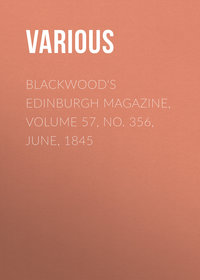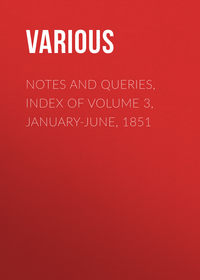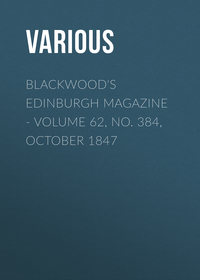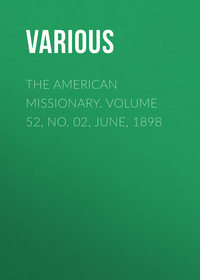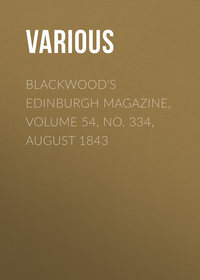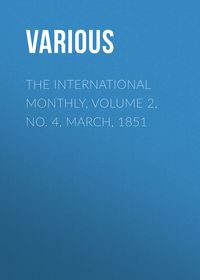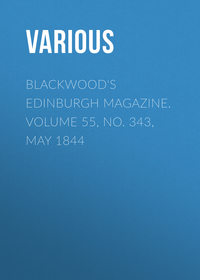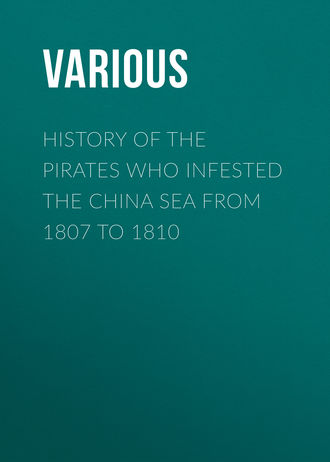 полная версия
полная версияHistory of the Pirates Who Infested the China Sea From 1807 to 1810
1809.
On the twenty-fifth the pirates went to Hëang shan and to great Hwang po;79 they took possession of the inside and the outside passage of Hwang po, so that the boat-people,80 who stay outside on the coast, retired and came up to the town with their boats. The military officer Ting gaou ho being made acquainted with the arrival of the pirates, requested ten fishing boats from the town Hëang shan to assist the citizens and to help them in opposing the enemy. He posted himself before the town to protect it. Ting gaou behaved valiantly on the river; he headed his small fleet of fishing boats and opposed the pirates. There was incessant(2 v.) fighting day and night; but at last the numerous vessels of the pirates surrounded him on all sides, and Ting gaou ho received a severe wound in the back. He then addressed his comrades in the following words:
"Being on[Pg 55] the military station before this town, it was my intention to destroy the pirates, and for this reason I united with all the principal men to oppose them, without considering my own safety; – joyful I went to oppose the enemy. But not being able to destroy this immense number of banditti, I am now surrounded with all my principal men; and being deficient in power, I will die. Death could not move me, but I fear the cruel behaviour of the banditti; I fear that if the battle come to its highest summit, our fathers and mothers, our wives and sons, will be taken captives. United with the principal men of the town, we cannot destroy the pirates, neither protect the country, our(3 r.) families, nor our own firesides, – but the circumstances being desperate, we must do our utmost."81
1809.
They now again rushed against the pirates and killed many of them; but their strength being exhausted, the ten fishing boats were taken, and great Hwang po given up to be plundered. The citizens retired to their intrenchments, and made such vigorous resistance that the pirates could not make them captives. Chang paou therefore ordered O po tae and Leang po paou to make an attack on both sides, on the front and the rear at once; so the citizens sustained a great defeat, and about a hundred of them were killed. A placard was then posted up in the town, admonishing the citizens that they being unable to resist the enemy, must, under these cruel circumstances, send messengers to make terms with the pirates. This(3 v.) being done, the pirates withdrew.
1809.
The wife of Ching yih then ordered the pirates to go up the river; she herself remaining with the larger vessels in the sea to blockade the different harbours or entrances from the sea-side; but the government officers made preparations to oppose her. There were about this time three foreign vessels returning to Portugal.82 Yĭh's wife attacked them, took one vessel, and killed about ten of the foreigners; the two other vessels escaped. The Major Pang noo of Hëang shan about this time fitted out a hundred vessels to attack the pirates; he had before hired six foreign vessels, and the two Portuguese ships, which had before run away, united also with him. Yĭh's wife, seeing that she had not vessels enough, and that she might be surrounded, ordered a greater number to her assistance.(4 r.) She appointed Chang paou to command them, and sail up the river; but to keep quiet with his squadron till he saw the Chang lung, or government vessels come on. On the third of the tenth moon the government vessels went higher up the river, and Chang paou following and attacking them, the foreign vessels sustained a great loss, and all the other vessels then ran away. The foreigners showed themselves very courageous; they petitioned the mayor of Hëang shan to place himself at the head of the foreign vessels, to go and fight the pirates. Pang noo having for some time considered their request, inspected on the tenth of the same month the six foreign vessels, their arms and provisions, and went out into the sea(4 v.) to pursue the pirates.
About this time Chang paou had collected his force at Ta yu shan near Chih leih keŏ, and the foreign vessels went thither to attack him. About the same time the admiral, Tsuen mow sun, collected a hundred vessels, and joined the foreigners to attack the pirates. On the thirteenth they spread out their lines, and fought during two days and two nights, without either party proving victorious. On the fifteenth one of the officers went forward with some large vessels to attack the pirates, but he was very much hurt by the fire of the guns; his vessel was lost, and about ten men were killed and many others wounded, – after this, the whole fleet retired. They however again commenced fighting on the sixteenth, but being unable to withstand the pirates, one vessel more was lost.83
1809.
(5 r.)
(5 v.)
The Admiral Tsuen mow sun was exceedingly eager to destroy the pirates, but he was confident that he was not strong enough to vanquish them, and he spoke thus to his people: "The pirates are too powerful, we cannot master them by our arms; the pirates are many, we only few; the pirates have large vessels, we only small ones; the pirates are united under one head, but we are divided, – and we alone are unable to engage with this overpowering force. We must therefore now make an attack, when they cannot avail themselves of their number, and contrive something besides physical strength, for by this alone it is impossible for us to be victorious. The pirates are now all assembled in Ta yu shan, a place which is surrounded by water. Relying on their strength, and thinking that they will be able to vanquish us, they will certainly not leave this place of retirement. We should therefore from the provincial city (Canton) assemble arms and soldiers as many as we can, surround the place, and send fire-vessels among their fleet. It is probable that in such a manner we may be able to measure our strength with them."
1809.
In consequence of this determination all commanders and officers of the different vessels were ordered to meet on the seventeenth at Chih leih keŏ, to blockade the pirates in Ta yu shan, and to cut off all supplies of provisions that might be sent to them. To annoy them yet more, the officers were ordered to prepare the materials for the fire-vessels. These fire-vessels were filled with gunpowder, nitre, and other combustibles; after being filled, they were set on(6 r.) fire by a match from the stern, and were instantly all in a blaze. The Major of Hëang shan, Pang noo, asked permission to bring soldiers with him, in order that they might go on shore and make an attack under the sound of martial music, during the time the mariners made their preparation. On the twentieth it began to blow very fresh from the north, and the commander ordered twenty fire-vessels to be sent off, when they took, driven by the wind, an easterly direction; but the pirate's entrenchments being protected by a mountain, the wind ceased, and they could not move farther on in that direction; they turned about and set on fire two men of war. The pirates knowing our design were well prepared for it; they had bars with very long pincers, by which they took hold of the fire-vessels and kept them off, so that they could not come near. Our commander, however, would not leave the place; and being very eager to fight, he ordered(6 v.) that an attack should be made, and it is presumed that about three hundred pirates were killed. Pao now began to be afraid, and asked the Spirit of the three Po, or old mothers, to give a prognostic. The Păh, or lot for fighting, was disastrous; the Păh, or lot to remain in the easterly entrenchment, was to be happy. The Păh, or lot for knowing if he might force the blockade or not on leaving his station to-morrow, was also happy,84 three times one after another.
1809.
There arose with the day-light on the twenty-second a light southerly breeze; all the squadrons began to move, and the pirates prepared themselves joyfully to leave their station. About noon85 there was a strong southerly wind, and a very rough sea on. As soon as it became dark the pirates made sail, with a good deal of noise, and broke through the blockade, favoured by the southerly wind. About a hundred vessels were upset, when the pirates left Ta yu shan. But our commander being unaware that the pirates would leave their entrenchments, was not prepared to withstand them. The foreign vessels fired their guns and(7 r.) surrounded about ten leaky vessels, but could not hurt the pirates themselves; the pirates left the leaky vessels behind and ran away. After this they assembled outside at Hung chow in the ocean.
1809.
Notwithstanding that the pirates had broken through the blockade, Tsuen mow sun desisted not from pursuing them; he followed the pirates into the open sea in order to attack them. On the fifth of the eleventh moon he met the pirates near Nan gaou, and prepared his vessels86 to attack them. The pirates spread out all their vessels one by one, so that the line of their fleet reached the forces of our commander; they then tried to form a circle and surround our admiral. Our commander, in order to prevent this, divided(7 v.) his force, – he separated from him eighty vessels, which had orders to join him afterwards. Before they united again, a great battle took place between the two fleets; the firing lasted from three till five in the afternoon; our crew fought exceedingly hard and burnt three pirate-vessels. The pirates retreated, and our navy declined pursuing them, because it would carry them too far out of the way. Our crew being still elated at this transaction, the pirates on a sudden returned, roused them out of their sleep and constrained them to fight a second time. The commander had no time to make preparations, so that two vessels were burnt by the fire of the pirates, and three were captured.
1809. (8 r.)
At the time when Chang paou was blockaded in Chih leih keŏ, and was afraid that he should not be able to come out again, he sent to O po tae, who was at Wei chow, to rescue him. His message was in the following words: – "I am harassed by the government's officers outside in the sea; lips and teeth must help one another, if the lips are cut away the teeth will feel cold. How shall I alone be able to fight the government forces? You should therefore come at the head of your crew, to attack the government squadron in the rear, I will then come out of my station and make an attack in front; the enemy being so taken in the front and rear, will, even supposing we cannot master him, certainly be thrown into disorder."
Ever since the time Paou was made chieftain there had been altercations between him and O po tae. Had it not have been out of respect for the wife of Ching yĭh they would perhaps have(8v.) made war against each other. Till now they only showed their mutual dislike in their plundering expeditions on the ocean, and in consequence of this jealousy Po tae did not fulfil the orders of Paou. Paou and his whole crew felt very much annoyed at this conduct, and having been able to break through the blockade, he resolved to measure his strength with Tae. He met him at Neaou chow, and asked him: "Why did you not come to my assistance?"
1809.
O po tae answered: "You must first consider your strength and then act; you must consider the business and then go to work. How could I and my crew have been sufficient against the forces of the admiral. I learnt your request, but men being dependent upon circumstances, I could not fulfil it; I learnt your request, but I was dependent on circumstances, and men(9 r.) cannot act otherwise.87 And now concerning this business – to give or not give assistance – am I bound to come and join your forces?"
Paou became enraged and said: "How is this, will you then separate from us?"
Tae answered: "I will not separate myself."
Paou: "Why then do you not obey the orders of the wife of Ching yĭh and my own? What is this else than separation, that you do not come to assist me, when I am surrounded by the enemy? I have sworn it that I will destroy thee, wicked man, that I may do away with this soreness on my back."
1809.
There passed many other angry words between them, till they at length prepared to fight and destroy each other. Chang paou was the first to begin the battle; but having fired his guns, and being deficient in strength, Tae went against him with all his well prepared forces. Paou was not able to make any effectual resistance to his enemy; he received a severe defeat, he lost sixteen vessels, and three hundred men(9 v.) were taken prisoners. The prisoners were all killed from mutual hatred.
O po tae remained then at the head of his forces without any opposition, since Paou withdrew. There was now a meeting held under these banditti; when Chang jih kao arose and said:
1809.
"If Paou and we should again measure our strength against each other, our force will not be found sufficient; we are only one to ten. It is to be feared that they will collect all their forces together to exterminate us. They may on a sudden come against us and make an attack, – our small body must certainly be in fear of their vast number. There is Leang po paou, an experienced pirate on the sea; if he should on a sudden turn his vessels against us, there is not one among us who would be able to resist him. He is a very zealous worshipper of the spirit of the three Po or Mothers, and protected by them; nay, and protected by them in a supernatural manner. But if we perform sacrifices,(10 r.) they remain without shadow and echo.88 And then it may also be added that we are no more able to withstand with our short arms their long ones, than dogs are able to chase fierce tigers. But do we not every where see government placards inviting us to submit, why do we not then send somebody to make the offer? The government will pardon and not destroy us sea-monsters,89 and we may then reform our previous conduct. Why should we not therefore come to a determination to that effect?"
Fung yung fa said: "How then if government should not trust our word?"
1809.
Chang jih kao answered: "If government should learn that we recently fought Chang(10 v.) paou, and destroyed the banditti, – it would be hard indeed if that were not enough to make them trust us?"
Go tsew he said: "If government should not act towards us, as it is stated in the placard, after having made our submission, we may then again use violence. But they will hear, that we attacked the others, like fishes their food; that we alone made a beginning in destroying the pirates, and then tendered our submission, – they will feel that they can employ us to destroy the other pirates. He who is not of the same opinion as mine may let his hand hang down."
O po tae was of the same opinion, and the purser was ordered to frame the offer of submission to government. The petition concerning the offer was couched in the following terms:
1809.
"It is my humble opinion that all robbers of an overpowering force, whether they had their origin from this or any other cause, have felt the(11 r.) humanity of government at different times. Leang shan who three times plundered the city, was nevertheless pardoned and at last made a minister of state.90 Wa kang often challenged the arms of his country and was suffered to live, and at last made a corner-stone of the empire. Joo ming pardoned seven times Mang hwŏ; and Kwan kung three times set Tsaou tsaou at liberty.91 Ma yuen pursued not the exhausted robbers; and Yŏ fei killed not those who made their submission. There are many other instances of such transactions both in former and recent times, by which the country was strengthened and government increased its power. We(11 v.) now live in a very populous age; some of us could not agree with their relations, and were driven out like noxious weeds. Some after having tried all they could, without being able to provide for themselves, at last joined bad society. Some lost their property by shipwrecks; some withdrew into this watery empire to escape from punishment. In such a way those, who in the beginning were only three or five, were in the course of time increased to a thousand or ten thousand, and so it went on increasing every year. Would it not have been wonderful if such a multitude, being in want of their daily bread, should not have resorted to plunder and robbery to gain their subsistence, since they could not in any other manner be saved from famine? It was from necessity that the laws of the empire were violated, and the merchants robbed of their goods. Being deprived of our land and of our native places, having no house or home to resort to, and relying only on the(12 r.) chances of wind and water, even could we for a moment forget our griefs, we might fall in with a man-of-war, who with stones, darts and guns, would blow out our brains.
"Even if we dared to sail up a stream and boldly go on with anxiety of mind under wind, rain, and stormy weather, we must every where prepare for fighting. Whether we went to the east, or to the west, and after having felt all the hardships of the sea, the night dew was our only dwelling, and the rude wind our meal. But now we will avoid these perils, leave our connexions, and desert our comrades; we will make our submission. The power of government knows no bounds; it reaches to the islands in the sea, and every man is afraid and sighs. Oh we must be destroyed by our crimes, none can escape who opposeth the laws of government. May you then feel compassion for those who(12 v.) are deserving of death; may you sustain us by your humanity!"
1809.
The chief officers of government met joyfully together at Canton. The governor-general of the southern district ever loved the people like himself; and to show his benevolence he often invited them by public placards to make submission: – he really felt compassion for these lower sort of men, who were polluted with crimes. The way of compassion and benevolence is the way of heaven, which is pleased with virtue; it is the right way to govern by righteousness. Can the bird remain quiet with strong wings, or will the fish not move in deep water? Every person acts from natural endowments, and our general would have felt compassion even for the meanest creature on earth, if they would have asked for pardon. He therefore redeemed these pirates from destruction, and pardoned their former crimes.92
1809.
After this period the country began to assume a new appearance. People sold their arms and(13 r.) bought oxen to plough their fields; they burned sacrifices, said prayers on the top of the hills, and rejoiced themselves by singing behind screens during day-time. There were some people who endeavoured to act with duplicity, and wished to murder the pirates, but the general on seeing the petition said to his assistants: "I will pull down the vanguard of the enemy to use it for the destruction of the remaining part. I may then employ it against the over-spreading power of the pirates; with the pirates I will destroy the pirates. Yŏ fu mow destroyed in this manner Yang tay: let us not act with duplicity, that we may the better disperse their comrades and break their power; let us therefore accept their submission."
Jan. 1810.
In the agreement it was stipulated that the ships should assemble together in the open sea near Kwei shen hëen93 to make their surrender. The Governor-general was to come to that place(13 v.) to receive O po tae, his vessels, his men, and all other things which were pointed out in the petition. The Governor-general being exceedingly pleased, ordered his adjutant Kung gaou to examine the list. He found eight thousand men, one hundred and twenty-six vessels, five hundred large guns, and five thousand six hundred various military weapons. The towns Yang keang and Sin gan were appointed for this people to live in.94– This happened in the twelfth month of the fourteenth year of Këa king – and so the black squadron was brought into subjection. O po tae changed his name to Heŏ bëen, "The lustre of instruction," and the general made him a Pa tsung95 to reward his services in defeating Chang paou.
1810. (14 r.)
On the twelfth moon Chang paou went with his different squadrons into the river and attacked Ke chow. It was near the end of the year, and the pirates assembled along the mountain ridge Laou ya96 to make a festival: they made a great noise during the night with crackers, and their gongs were heard at a great distance.97 At daybreak the flags were spread out, and the drums sounded; they were cheerful the whole day; they eat and drank and made a great noise, which was heard many les off.
1810.
On the second day of the same month they attacked the village, and on the third day about ten men went on shore. The villagers made their escape, so that the pirates could not take them. Having some time before made preparations to fortify Ma king yun.98 they now retired to it. The pirates knowing that the villagers were well provided for defence, waited until(14 v.) they had every thing ready. On the fourth the pirates landed; it was in vain that the villagers opposed them, they had two men wounded, and were finally defeated. The Governor-general ordered Ching chuy loo to proceed at the head of a large body of soldiers to the town Shun tih, and prepare for an attack. Meeting the pirates at Ke chow, the Major attacking them on a sudden, the pirates sustained a great loss, and returned to their vessels. The Major also was struck by a shot from a musket. There were daily skirmishes at the neighbouring places; the inhabitants were generally defeated and ran away. The Major Loo came with his forces and placed them on the sea-coast behind the intrenchments of Sin ne, to protect them against the fire of the enemy. The guns of the pirates were directed against the place, the bullets fell in Sin ne, but without hurting any one, which again calmed and encouraged the inhabitants. The pirates(15 r.) coming a second time before Ke chow and Ta leang, and not being able to accomplish their designs, thought fit to retire.
1810.
The wife of Ching yĭh, on seeing that O po tae was made a government officer after his submission, and that he did well, thought also of making her submission. "I am," said she, "ten times stronger than O po tae, and government would perhaps, if I submit, act towards me as they did with O po tae." But remembering their former crimes, and the opposition they made to many officers, these pirates were apprehensive and felt undetermined in their resolutions. A rumour(15 v.) went about, that the red squadron wished to tender their submission, and, in consequence, the vigilant magistrates hearing of this, invited them to do so. The magistrate of Tsze ne, Yu che chang, ordered a certain Fei hëung chow to make enquiries about the matter. Fei hëung chow was a physician of Macao, and being well acquainted with the pirates, he was not in need of any introduction to obtain access to them. This was the ground on which Yu chi chang particularly selected him, when he tried to bring the pirates to submission.
When Fei hëung chow came to Paou, he said: "Friend Paou, do you know why I come to you?"
Paou. – "Thou hast committed some crime and comest to me for protection?"
Chow. – "By no means."
1810.
Paou. – "You will then know, how it stands concerning the report about our submission, if it is true or false?"
Chow. – "You are again wrong here, Sir.99 What are you in comparison with O po tae?"
Paou. – "Who is bold enough to compare me(16 r.) with O po tae?"
1810.
Chow. – "I know very well that O po tae could not come up to you, Sir; but I mean only, that since O po tae has made his submission, since he has got his pardon and been created a government officer, – how would it be, if you with your whole crew should also submit, and if his Excellency should desire to treat you in the same manner, and to give you the same rank as O po tae? Your submission would produce more joy to government than the submission of O po tae. You should not wait for wisdom to act wisely; you should make up your mind to submit to the government with all your followers. I will assist you in every respect, – it would be the means of securing your own happiness and the lives of all your adherents."
Chang paou remained like a statue without motion, and Fei hëung chow went on to say:(16 v.) "You should think about this affair in time, and not stay till the last moment. Is it not clear that O po tae, since you could not agree together, has joined government. He being enraged against you, will fight, united with the forces of the government, for your destruction; and who could help you, so that you might overcome your enemies? If O po tae could before vanquish you quite alone, how much more can he now when he is united with government? O po tae will then satisfy his hatred against you, and you yourself will soon be taken either at Wei chow or at Neaou chow. If the merchant-vessels of Hwy chaou, the boats of Kwang chow, and all the fishing-vessels unite(17 r.) together to surround and attack you in the open sea, you will certainly have enough to do. But even supposing they should not attack you, you will soon feel the want of provisions, to sustain you and all your followers. It is always wisdom to provide before things happen; stupidity and folly never think about future events. It is too late to reflect upon events when things have happened; you should, therefore, consider this matter in time!"




